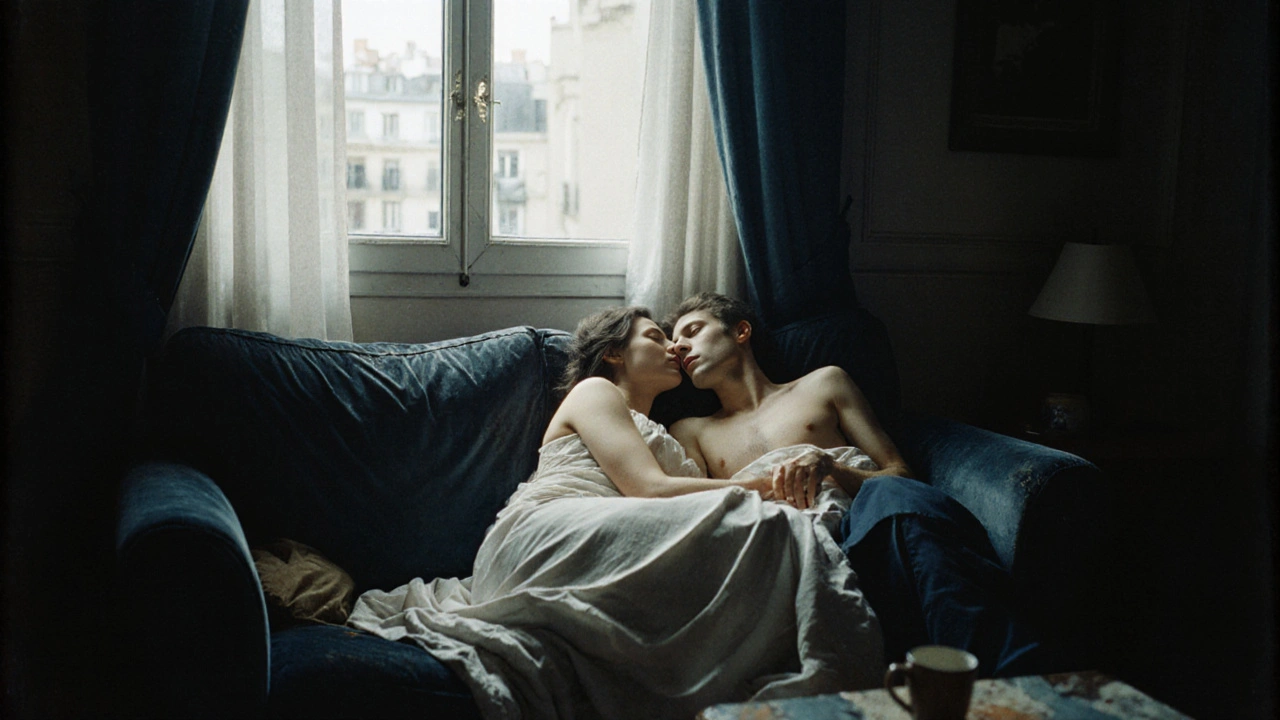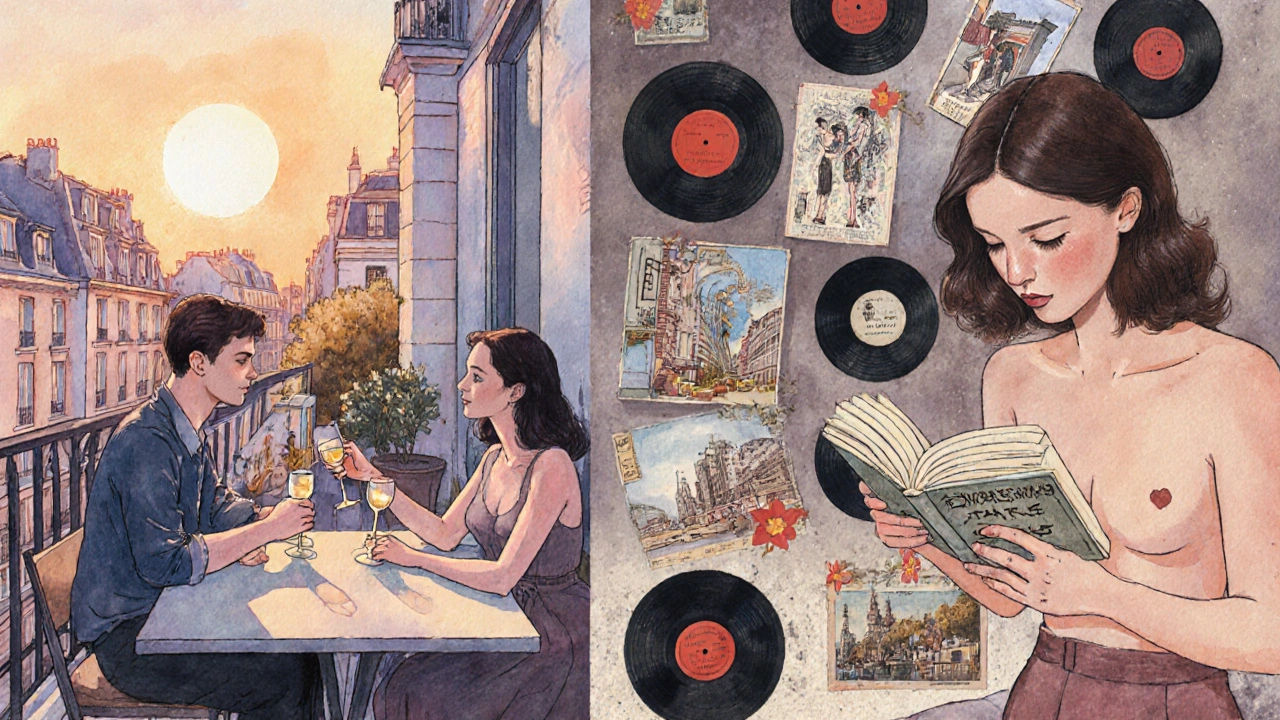In Paris, sexuality has never been hidden behind closed doors-it’s been painted on walls, projected on screens, and whispered in cafés since the 19th century. Unlike cultures that treat desire as something to be controlled or ashamed of, Paris has long embraced it as an art form. From the nude studies of Degas at the Musée d’Orsay to the raw intimacy of Jean-Luc Godard’s films, French creativity doesn’t just acknowledge sexuality-it celebrates it as a natural, beautiful, and deeply human force.
Art That Doesn’t Look Away
Walk through the Musée d’Orsay’s impressionist wing and you’ll see it: women bathing in soft light, lovers entwined in shadow, the quiet tension between a glance and a touch. These aren’t just pretty scenes-they’re declarations. In 1863, Manet’s Olympia caused a scandal because it showed a real woman, not an idealized goddess, staring back at the viewer with unapologetic confidence. Today, that same painting hangs in the same room, admired not for its shock value, but for its honesty.
At the Musée Rodin, the sculptures of Auguste Rodin don’t just depict bodies-they capture the pulse of connection. The Kiss isn’t a romantic fantasy; it’s a moment frozen in time, where skin meets skin, breath syncs, and desire is silent but deafening. Locals don’t rush past it. They pause. Some even return on rainy afternoons, just to stand in front of it, as if remembering what it feels like to be truly seen.
Parisian galleries like Galerie Perrotin and Galerie Thaddaeus Ropac don’t shy away from provocative work. In 2023, the exhibition Corps et Désir at the Centre Pompidou featured contemporary artists like Orlan and Sophie Calle, whose pieces explored consent, vulnerability, and the politics of the body. It wasn’t just an art show-it was a conversation happening in real time, with visitors debating in the café downstairs over espresso and pain au chocolat.
Cinema That Feels Real
French cinema doesn’t sell sex-it shows it. No slow-motion shots, no dramatic music, no close-ups of lips that never touch. Just bodies, in real rooms, in real light. Think of Blue Valentine-no, wait, think of La Vie d’Adèle. The long, quiet scenes between Adèle and Emma aren’t erotic because they’re hot-they’re erotic because they’re true. You see the way they argue, how they touch each other’s hair without saying a word, how they cry after sex and still hold on.
At the Cinémathèque Française in the 13th arrondissement, film students and retirees sit side by side watching Truffaut’s Jules et Jim or Chantal Akerman’s Je, tu, il, elle. These aren’t niche screenings-they’re packed. People come because they know French films don’t treat sexuality as a gimmick. It’s part of the story, like weather or bread or the sound of a Métro train rattling past your window.
Even in mainstream French films, sex is never glamorized. In Amour (2012), Michael Haneke shows an elderly couple’s final intimacy with heartbreaking simplicity. No music swells. No camera lingers. Just two hands, one trembling, the other steady, holding on. That scene made more people cry in Paris than any love scene in Hollywood. Because in France, sexuality isn’t about performance. It’s about presence.

Where Paris Lives It
You don’t need to go to a museum or a cinema to feel this. Walk down Rue de la Huchette in the Latin Quarter after dark and you’ll see couples talking over wine at tiny tables, their laughter mixing with the clink of glasses. Or visit the Marché aux Puces de Saint-Ouen on a Sunday morning-there’s no shortage of vintage lingerie, old French postcards of nudes, or 1920s erotic novels tucked between stacks of vinyl records. Locals browse them like they’re browsing cookbooks.
Even the city’s architecture reflects this openness. The balconies of Le Marais don’t just overlook streets-they frame moments. You see a man lighting a cigarette for his partner on the fifth floor, a woman reading naked on her terrace with the sun on her shoulders. No one looks away. No one calls the police. It’s just life.
Parisian spas like Thermes de Paris in the 15th arrondissement offer couples’ rituals that blend massage, steam, and silence-not as a luxury, but as a return to the body. No nudity is forced. No pressure. Just space to be soft, to be still, to be human. And people come back, week after week.

Why It Works
France doesn’t separate sex from art because it doesn’t separate sex from life. In Paris, you can walk from a Picasso exhibit to a bistro where a couple is sharing a bottle of wine and a plate of oysters, then to a screening of a new film by Claire Denis-all in one afternoon. There’s no disconnect. No guilt. No need to apologize for desire.
This isn’t about being “liberal.” It’s about being honest. French culture teaches that the body is not a problem to be solved, but a language to be understood. Sexuality isn’t something you buy at a sex shop or stream on an app. It’s something you feel in the brush of a hand on your arm in a crowded metro, in the way someone looks at you when you’re laughing too hard at a café, in the silence between two people who’ve loved each other for years and still don’t need words.
What You Can Learn From Paris
If you’re visiting Paris, don’t just see the Eiffel Tower. Go to the Musée Rodin at 5 p.m. on a Tuesday. Sit on the bench beside The Kiss. Watch how people react. Notice who lingers. Who smiles. Who looks away.
If you live here, take a day off and visit the Cinémathèque. Watch something old. Watch something strange. Watch something quiet. Let yourself feel what the films are showing-not just what they’re saying.
And if you’re ever unsure how to talk about desire, remember this: Paris doesn’t teach you how to seduce. It teaches you how to be present. How to listen. How to let someone else be real. That’s the real art.
Why is French art and cinema different when it comes to sexuality?
French art and cinema treat sexuality as part of everyday human experience, not as something to be sensationalized or hidden. Unlike American media that often sexualizes for profit or shock, French creators focus on authenticity-showing intimacy as quiet, messy, real. Think of films like La Vie d’Adèle or paintings like Manet’s Olympia: they don’t ask you to admire-they ask you to recognize.
Where can I see French erotic art in Paris today?
The Musée d’Orsay and Musée Rodin are essential for classical works. For contemporary pieces, visit Galerie Perrotin in the 3rd arrondissement or the Centre Pompidou, which regularly hosts exhibitions like Corps et Désir. Smaller galleries like Galerie Thaddaeus Ropac and Le Plateau also feature bold, body-focused work. Don’t miss the annual Festival du Film d’Art in Montmartre, which showcases avant-garde films exploring desire and identity.
Are there places in Paris where sexuality is openly celebrated in public?
Public displays of affection are common and accepted in Paris-especially in neighborhoods like Le Marais, Saint-Germain-des-Prés, and the 10th arrondissement. You’ll see couples kissing on bridges, reading together on benches along the Seine, or sharing meals at sidewalk cafés without judgment. The city’s culture doesn’t police intimacy; it assumes it’s natural. Even in crowded areas like Place des Vosges, people are more likely to smile than stare.
How do Parisians view nudity in art versus in daily life?
There’s no contradiction. Parisians see nudity in art as an expression of truth, not provocation. In daily life, nudity is respected in context-saunas, beaches like Plage de la Villette, or private spaces. But unlike in some cultures, there’s no shame in the body itself. A woman reading naked on her balcony isn’t seen as exhibitionist; she’s seen as comfortable. That comfort comes from decades of cultural norms that value authenticity over propriety.
Is French cinema still relevant in how it portrays sexuality today?
Absolutely. Directors like Céline Sciamma (Portrait of a Lady on Fire) and Alice Diop (Saint Omer) continue the tradition with films that explore desire through emotion, not spectacle. Their work is shown in Parisian cinemas like L’Ecran in the 14th and Le Grand Rex downtown. Audiences don’t go to be titillated-they go to feel something real. That’s why French cinema still leads the world in honest portrayals of sexuality, even as Hollywood leans into fantasy.

